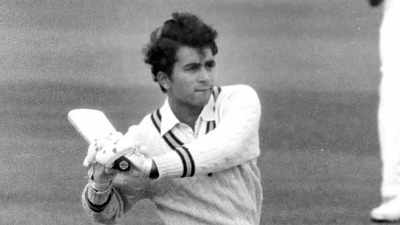NEW DELHI: India batting legend Sunil Gavaskar made a significant mark in the Ranji Trophy, India’s premier domestic cricket competition. He played for Bombay (now Mumbai) and was a key player in their dominance during the 1970s and 1980s.
Gavaskar was one of the leading scorers in the Ranji Trophy, consistently amassing runs. His ability to score heavily in the domestic circuit mirrored his success on the international stage.
Gavaskar’s performances in the Ranji Trophy were characterized by consistency.He scored numerous centuries and provided Mumbai with solid starts, helping the team win several titles during his time.
But there was one match when Gavaskar batted left-handed in a Ranji Trophy match.
In the Ranji Trophy semi-final against Karnataka at the M Chinnaswamy Stadium in the 1981-82 season, Gavaskar came down the order and batted left-handed to counter the spin of Raghuram Bhatt on a pitch that was turning square.
Talking to India off-spinner Ravichandran Ashwin on his YouTube channel, Gavaskar revealed the reason why he batted left-handed.
Gavaskar said, “It was quite funny, because on Day 1 Raghuram Bhatt was turning the ball square and I was batting on 40 something in the first innings and I got out to him, playing forward, ball turned and Vishy (Gundappa Viswanath, who is also Gavaskar’s brother-in-law) caught me at first slip.”
Gavaskar continues, “So when it came to Day 4 of the semi-finals, and we were facing defeat at that stage, so I said to the manager, who was a former Mumbai player, ‘I am going to bat left-handed.’ He said ‘no no you can’t do that.’ I said look if I bat right-handed, I have no chance, he (Raghuram Bhatt) is going to get me in a few deliveries, because the ball spinning and turning away from you is more likely to get you out.’ Because I was the captain I did it because I knew that playing left-handed I would play where the ball landed, as I right-hander when you’re little more accomplished and you’re a left0handed you anticipate the turn and your bat goes according to the turn and therefore there’s more chance of the bat meeting the ball on the edge and you getting out. As a left-hander, which I had never ever done even in the nets before, or even in my house before, I said let me go and try that. And that’s exactly what happened I was playing where the ball was pitching, ball was turning and hitting me in the side or hitting me on the thigh pad. And that’s it, that’s how I survived playing Raghuram Bhatt and there was another leg-spinner, that’s how I batted.”
Gavaskar adds, “At that particular stage, there were a lot of people who thought I had done it out of pique because Mumbai had lost, but it wasn’t, it was purely and simply a tactical thinking, what you call nowadays out of the box thinking. I just said ‘let me try’. Having said that, let me tell you, if it was playing for India, I wouldn’t have done that for sure. But here the match was gone, we had no chance, it was a matter of just trying to survive an innings defeat and that’s what we did.”
Mumbai, historically a dominant team in the Ranji Trophy, often benefited from Gavaskar’s contributions at the top of the order. He was instrumental in many of their triumphs during his era.
Although Gavaskar was known for his Test exploits, his ability to grind out long innings was evident in the Ranji Trophy as well. His technical proficiency and temperament made him a force to be reckoned with.
Gavaskar’s legacy in the Ranji Trophy is remembered as much as his international career, as he set an example for domestic players with his dedication and skill. His success in both domestic and international cricket established him as one of India’s most celebrated cricketers.
